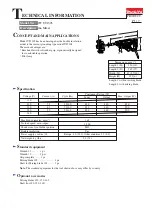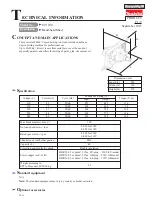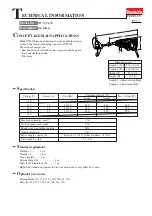
1. POWER SWITCH:
The adjacent yellow LED will light when power to the MM 12 is turned
on by means of this switch.
2. INPUTS:
These automatic balanced/unbalanced three-pin jacks are to be used for both
microphone or line level inputs. Rane adheres to the international standard pin configuration.
which is:
Pin I: Case ground.
Pin 2: Hot (signal).
Pin 3: Circuit ground.
3. PATCH OUTPUTS:
The MM 12 provides a hard-wire type splitter which allows the input
to each channel to be patched back out to the main mixing console or other equipment. The
MM 12 simply ”taps” off each splitter with high impedance amplifiers, without causing any
noise contribution, distortion or signal degradation to the main mix.
4. ACCESSORY LOOP:
These stereo l/4” jacks allow the insertion of effects, additional EQ
or the like in series with the input stage. These jacks are located POST EQ with the following
Tip/Ring/Sleeve (TRS) configuration:
Tip is SEND (output)
Ring is RETURN (input)
Sleeve is GROUND
These LOOP jacks may also be used to patch channels 1 a, 8a, 8b or 8c to the AUX inputs of the
other channels, using a mono patch cord. Refer to Section IV-1B.
5. AUX INPUT:
This is a SUMMING input which allows another line level signal to be added
to the regular input program. This input is POST EQ, and can also be used to reassign channels
1a, 8a, 8b, or 8c; refer to Section IV-1B.
6. OVERLOAD INDICATOR:
This red LED will light wheneverthe input stage reaches 4 dB
below clipping. More than occasional blinking of this LED means that the input gain control
should be turned down to avoid clipping.
7. INPUT GAIN CONTROL:
This varies the gain of the input stage to suit the requirements
of various microphones, instruments and line level equipment ranging from a minimum of 10
dB in the LINE mode to a maximum of 70 dB in the MIC mode.
8. MIC/LINE SWlTCH:
In the MIC position (out) the input stage has a gain range of 20 dB to
70 dB; in the LINE position (in) the gain has a range of 10 dB to 30 dB.
9. INPUT EQUALlZATlON SECTlON: The BASS control pr-14 dB of boost/cut at 20
Hz. shelving type. The MIDRANGE control is a bandpass filter centered at 1k Hz which
pr-10 dB of boost/cut The TREBLE control pr-12 dB of boost/cut at 20k HZ.
shelving type.
10.
MAINS INPUT:
Plug the stereo headphone output from the main mixing console into
this input then you will hear the main mix program through headphones plugged into the MM
12.
Whenever any of the CUE buttons on the MM 12 is pressed, the mains input will be
bypassed and you will hear the desired mix in the MM 12. You may also use a stereo l/4” patch
cord to connect the Mains Input to any of the input LOOP jacks to achieve input cueing-see
the following note for wiring requirements.
NOTE:
To use the Mains Input for cueing input signals with the headphones, use a
stereo l/4” patch cord WITH THE TIP AND RING CONNECTED TOGETHER at either
end. This will allow you to cue any input through the LOOP jack without removing the
signal from any of the MM 12 outputs. IF A MONO PATCH CORD IS USED FOR INPUT
CUEING, THE INPUT SIGNAL WILL BE REMOVED FROM THE MIX OUTPUTS SINCE
THE LOOP RETURN IS BEING GROUNDED.
11. HEADPHONE OUTPUT: Plug any type of monitoring headphones into this stereo
output to monitor any of the MM 12 outputs using the CUE buttons as well as the mains mix
when no CUE button is depressed.































